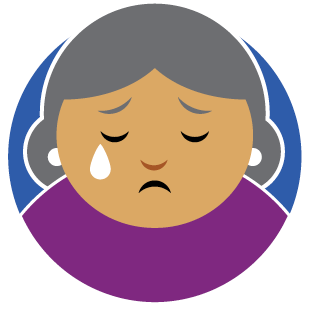This post is also available in: 简体中文 繁體中文
Common Emotions, Thoughts, and Behaviours
It is normal to feel a wide range of emotions during a crisis. You may feel sad, anxious, frustrated, confused, scared, and/or angry at any given time. You may find these emotions sometimes becoming more intense, while at other times, you may feel quite settled. This too is quite common. Emotions come and go and are an important part of our daily experiences.
How are you feeling today?
Happy

Great! For some people, the pandemic has created an opportunity to reflect on what is important in life and appreciate things that may have been taken for granted. There is no need to feel guilty about being in touch with happiness and contentment. Even in the midst of a pandemic, it is possible to be connected to our loved ones, to be in touch with our values, and to feel fortunate about the things we do have.
Sad

With the pandemic, many people will feel sad, “blue”, down in the dumps, or a loss of interest in things. These feelings can make it difficult to keep motivated and get moving. You may feel as though you are in a bit of a fog, and this can make you more tired or achy than usual. You may also notice restlessness or even a sense of meaninglessness or hopelessness. The physical isolation from friends and family may make you feel lonely and contribute to the sadness. For a lot of people, they are a part of the normal reactions to life stress, loss, or grief. Some helpful actions include utilizing coping strategies, practising self-care, connecting with others for social support, and getting professional help.
Anxious / Fearful

The pandemic can trigger fears, worries, and anxiety. We are not certain of what will happen tomorrow, next week, next month, or even next year from now. This can be difficult to tolerate. You may notice a sense of restlessness and unease that makes it hard to focus on anything. Fear and anxiety can trigger bodily sensations as your body gets ready for a “fight-or-flight” response. You may experience racing heartbeat, shortness of breath, cold sweat, shakiness, or dizziness. You may find yourself worrying about the worst-case scenarios. Actually, anxiety and worries are part of a normal response to stress and can be useful. It alerts us to be careful and motivates us to respond to challenges, such as carrying out the appropriate preventive measures. At the same time, being overly focused on our anxiety can feel draining and makes it harder to get everyday tasks done. We may start to engage in avoidance behaviours deliberately or subconsciously, from overeating to yelling at others to using alcohol or drugs. Some helpful actions include limiting excessive triggers, utilizing coping strategies, practising mindfulness, and getting professional help.
Surprised / Shocked

During this time, we are exposed to constant bombardment of breaking news stories and latest statistics. We experience sudden restrictions and dramatic changes to our lifestyle due to evolving policies and regulations. We may also know of people who are suffering or dying. This can all leave us feeling helpless, numb, lost, disoriented, surprised, shocked, paralyzed, or unable to respond. This can be a part of the normal reaction to sudden unexpected life stress or threats. Like all emotions, this will pass as we get through this pandemic. During this challenging time, it may be helpful to practice mindfulness to bring us back to the present moment so that we can process information again and deal with the current stress more effectively.
Angry

When we get angry, we may feel our hearts racing, blood rushing, teeth clenching, and our bodies heating up. With the pandemic, many things may trigger anger, such as losing income or jobs, having to adopt to changing guidelines and restrictions, loss of normalcy and freedom, frustration with government or other people’s responses to the pandemic, experiences of discrimination, or even as part of a grief reaction. We experience anger when we feel that things are unfair, that we are wronged, and that we do not deserve the negative things that we are having to deal with. Anger sometimes can also arise from other emotions too, such as fear, frustration, or powerlessness about things we cannot control. We may unknowingly take out our anger on those around us, such as yelling at our loved ones. Some people find slowed breathing, counting from 1 to 10, and walking away from a tense and anger-provoking situation helpful, so that we can be calmer before reacting to it. It is also important to become more aware of our emotions, take steps to better understand them, and practice kindness and compassion for ourselves and for others.
Below, we list a few basic steps to better understand and deal with our emotions:
1. Be aware that having difficult emotions is common. You may have any or all of the above emotions during the COVID-19 pandemic.
2. Connect to and identify your current emotions in an open, non-judgemental way. What are the emotions you are currently feeling?
3. Relate emotions to your current human needs and wants. What needs are being met or not met when you are experiencing these emotions?
4. Be open to connecting to your emotions and take helpful actions. “What can I do or not do as I allow these emotions to unfold?”
5. Notice that emotions change. You may feel sad or angry now. You won’t feel this way forever.
6. This website has many mental health tips. Explore each section and discover how to build your resilience!

